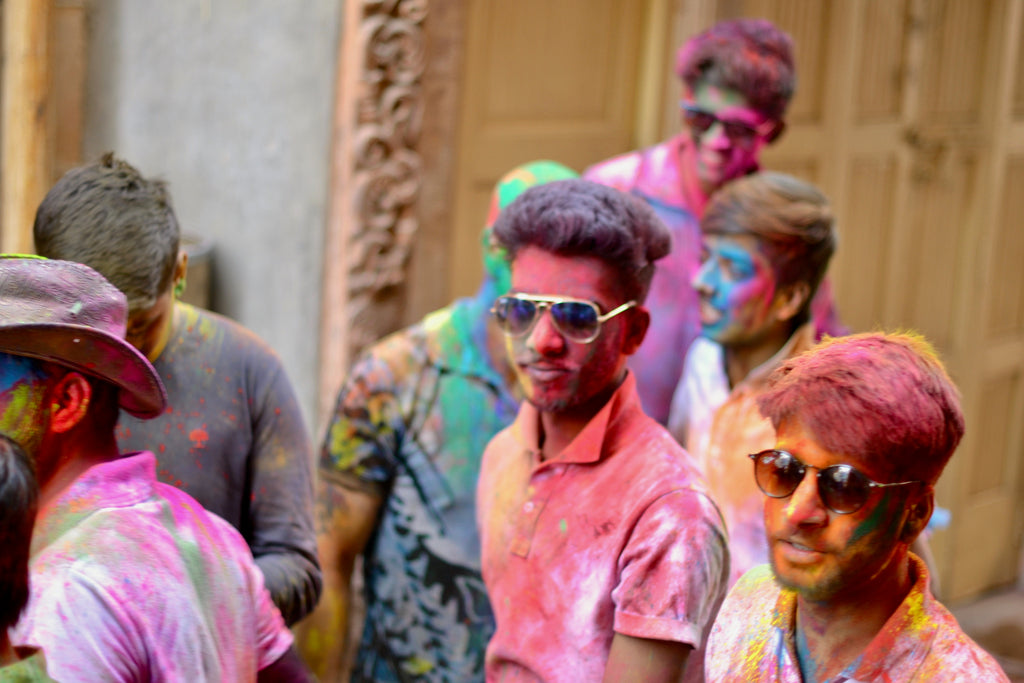Indian Festivals: Holi - The Festival of Colour
By Conchita de Souza

My first Holi experience was in the town of Vrindavan, the place in which Lord Krishna grew up and where over 5,000 temples stand in honour of this blue-skinned, much adored deity. I had driven with two flatmates/colleagues to this town very early in the morning from Delhi, and checked into a hotel where another friend was waiting, oiled my hair and body in anticipation of the staining effect of the colours, and changed into a set of old clothes for immediate disposal. As we walked the narrow lanes, slowly filling up with people as they woke up to the excitement, everything seemed eerily calm and quiet. I remember thinking to myself ‘well this ain’t as bad as I thought, at least people are being civil’. There were many a cart on the street selling loose colourful powders, embarrassing my organic and chemical-free organic powders from the supermarket. My friends and I playfully threw colour on each other, lest we appeared too clean for others to want to throw colour on us.
It must have been only 8.00am when things began to quickly and unexpectedly intensify. I remember seeing a large crowd of coloured devotees coming out of a temple and shouting praises, and as they passed, they threw colour all over us. The onslaught began, and much like Jesus struggling through the narrow lanes of Jerusalem with the crowd all around him, we walked towards our colourful calvary. I put a scarf over my head to protect my eyes, but its effect was to attract more attention and, more colour. As we walked down the streets, children had filled buckets of coloured water and waited for us to pass so they could drench us from the terraces. Pichikaris (waterguns) were squirted from all directions, their owners seemingly innocent and playful. Men would not just throw colour on me, but smear my entire face with it as though attempting an express facial. There was colour in my eyes, my nostrils, my mouth and my ears. We entered the famous Banke Bihari temple, and through the clouds of colourful dust, paid our respects to the famous statue of Radha Krishna (Radha is Krishna’s consort, and he is rarely mentioned without her name being attached to his). As the morning wore on, and I became weary from all the drenching, I began ducking or covering my face so as to protect it from the cheerful and rowdy crowds. I soon realised that this actually encouraged them to target me even more, and they would smear me apologetically and uncontrollably, exclaiming ‘Bura na mano, Holi hai’ (don’t mind, it’s Holi). There were multiple and spontaneous outbursts of crowds dancing and cheering to the sound of colorful drummers and I was pulled in by the sheer joy of it all. Finally exhausted at 9.30am, I begged my friends to retire, as I, being a female, was far more drenched and coloured than what they were. We returned to the hotel and I jumped into the shower, washing my hair with shampoo at least three times before the water ran clear. Once we were cleaned up, we went out for a traditional and festive breakfast.

The meaning and significance behind Holi
Holi is probably the most fun of Indian festivals, that is if you don’t mind being bejewelled with a multitude of colours and squirted with water guns by friends and strangers alike. It is celebrated with more fervour in the North than compared with the South. Frivolities aside, its significance is more cultural than it is religious. The festival signifies the following:
-
The triumph of good over evil: The legend behind Holi is centered around the character Prahalad - the son of demon king Hiranyakashyap. This King considered himself to be ruler of the Universe and above all Gods because he was given a special boon, one which prevented him from dying an earthly death, except for in very unlikely circumstances. His son was a devotee of Lord Vishnu and when his Father asked him, “Who is the greatest, God or I?”, he responded with piety “God is, you are only a King”. This response infuriated the King who decided he would have to kill his own son and subjected him to many forms of torture, all of which Prahalad survived. Hiranyakashyap had a demon sister called Holika, and he asked her to sit in a pyre of fire wearing a special cloak, that would not allow her to burn. He then told his son Prahalad to sit with his aunt in the fire. The cloak worn by Holika fell on to Prahalad, and he survived the fire whilst his aunt burned. This is why, on the eve of Holi, a huge bonfire is lit and Holika’s effigy is burned.
-
The greatest of equalisers: Regardless of your age, gender, caste, class, culture or creed, you can play Holi with anyone and everyone. The traditional boundaries that divide communities and people are suspended during Holi to ensure no one misses out on the fun (unless of course you stay indoors).
- The beginning of Spring: Holi is celebrated just as winters quickly fade into the warmer spring season. The colours of Holi represent the brightness, warmth and joy brought on by the advent of Spring. It is always celebrated the day after the full moon.
Specialities
As with all festivals, comes an array of specialities and delights enjoyed during this time. They vary depending on which part of India you are celebrating an below are a few of the Holi classics.
-
Bhaang - The local name for marijuana and the natural drug associated with Lord Shiva, bhaang is enjoyed on this festive day in various forms. It is added to milky drinks such as Lassi, as well as to deep-fried snacks (such as pakoras, which you can make yourself using our Pakora spice blend).
-
Thandai - A chilled, sweetened and spiced milk drink which is sipped on by kids as they refuel between Holi games. The additions of dried fruits and nuts make Thandai a great energiser. Bhaang can also be added to this drink to get into the Holi spirit.

PC: @tashasartisanfoods
- Gujiya - A deep fried pastry which encases a soft and sweet mixture of dried milk and dried fruits. There are many variations of Gujiyas across India, depending on which region you are in.

PC: @whiskaffair
Happy Holi everyone!

0 comments